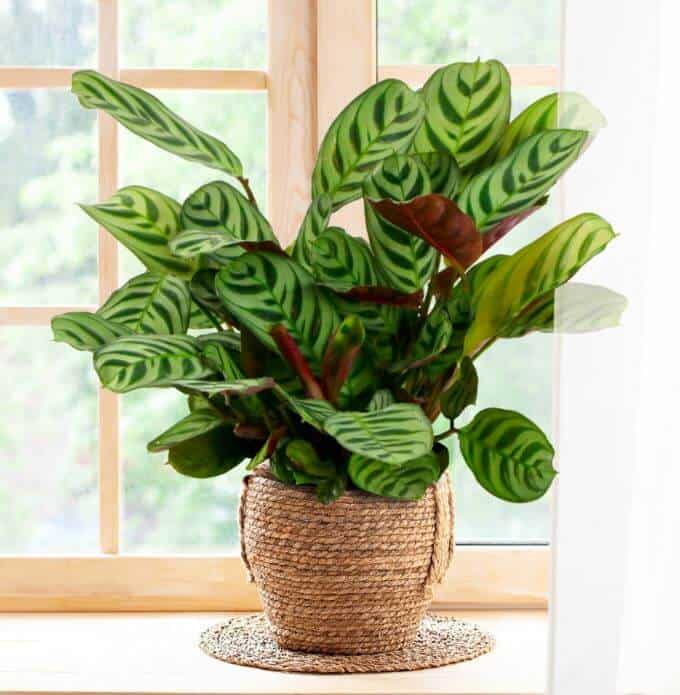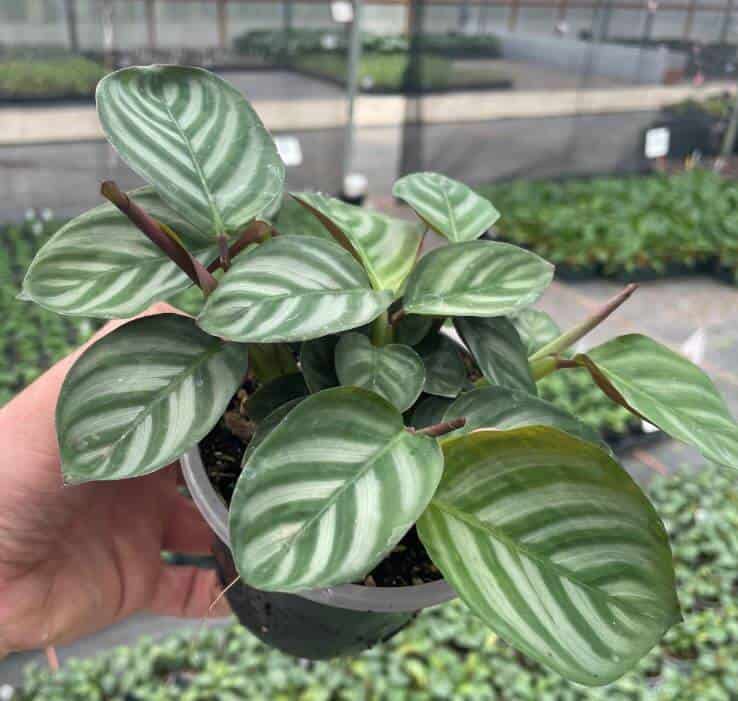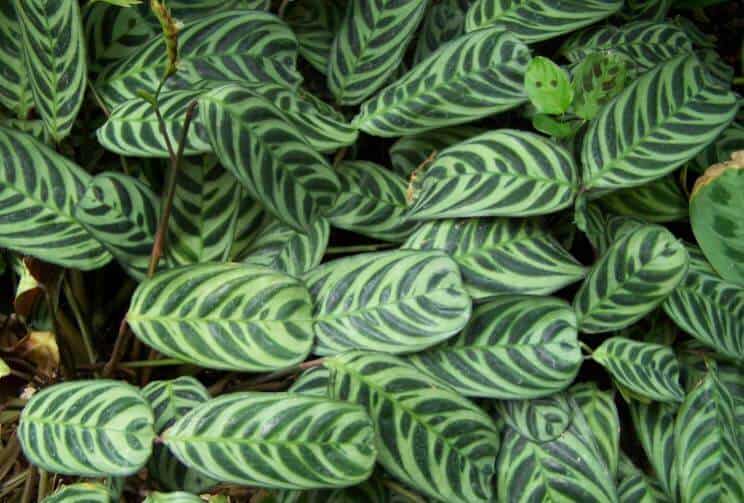Last Updated on March 31, 2023 by a Friendly Gardener
If you are a fan of Prayer plants, the Ctenanthe burle-marxii, merits consideration. Commonly called the “Fishbone Prayer Plant” or the “Blue Ice Plant”, it boasts a very unique foliage pattern that alternates between shades of light and dark green with a design that resembles a fishbone, hence its name.
The Calathea burlemarx is a nyctinastic plant meaning it will fold its leaves up at night when darkness arrives. This particular variety is named for Sr. Roberto Burle Marx, a plant enthusiast in the plant’s native habitat in Brazil.
When planted outside, the fishbone plant will produce insignificant tiny white flowers in early spring. Occasionally a houseplant will flower. Flowers are necessary for pollination, but it is the foliage that has rendered this plant popular. The Fishbone plant does not grow particularly tall, reaching heights between twelve and twenty inches. Widths can grow to spreads of sixteen inches.
These plants are slow growers and require at least two years to reach maturity. They do not produce a fragrance.
Fishbone Prayer Plant Care

Like other calathea species, the Fishbone Prayer plant prefers high humidity, bright indirect sunlight, and a moderate watering schedule. As a tropical native, this calathea requires care that is similar to most tropical plants. It is not necessarily a plant for beginners as it can be challenging.
Soil
Soil needs to be well-draining yet guarantee some measure of water retention. Soil pH should measure between 5.6 and 6.5. ideally, your potting soil mix should be amended with orchid bark or coco coir. Vermiculite can also be used. This will aid in guaranteeing water retention capabilities while at the same time ensuring drainage and soil aeration.
Light

To maintain the Fishbone plant’s characteristic variegation, this plant must have access to bright indirect light. In tropical rainforests, it is an understory plant, meaning it grows beneath a canopy of trees and taller vegetation where light is dappled or filtered. It should not be directly exposed to sunlight as this can scorch foliage especially if cultivated outdoors. If you are cultivating your plant indoors in low-light conditions, consider using a grow light.
Water
The Fishbone needs moderate watering. In this manner, you can avoid the risk of either underwatering or overwatering your plant. Water will need to be increased or reduced depending on the season with spring and summer requiring more water and winter requiring less. The soil bed should remain moist but not soggy. Root systems are rather fragile. The plant’s container must offer good drainage otherwise your plant may develop root rot. Calathea varieties can be fussy regarding water, so getting it right is an important part of maintaining your Fishbone plant healthy.
These plants are also sensitive to additives in tap water, so it’s recommended that collected rainwater or distilled water be used for watering.
Humidity
Humidity is important for tropical plants, and the Fishbone Prayer plant is no exception. Its native habitat is moist, so reproducing this type of humidity can be challenging. An indoor humidity of 60% is ideal. Consider using a space humidifier or a pebble tray placed beneath your plant. You can mist several times weekly which will help but this is not a long-term solution.
Temperature
As a tropical, the Calathea burlemarx prefers temperatures ranging between 65° and 75° F. It prefers a warm environment and can tolerate temps as high as 90°F. It does not like the cold and can suffer irreparable damage when exposed to low temps so avoid placing it in drafty spots or near air conditioning units or vents. If you want to cultivate your plant outdoors, you need to reside in US hardy zones 10 through 12.
Feeding

A Fishbone plant will benefit from fertilization during its growing season in the spring and summer. During winter rest, it does not need feeding. Use a balanced liquid houseplant fertilizer and dilute it to half-strength to prevent burning the roots. Frequent feeding will encourage this plant’s growth habit.
Pruning
These calatheas do not require specific pruning but if stems appear unruly, out of place, or leggy, you can prune your plant for a more compact appearance. Damaged, yellow, or dying leaves should be removed. Prune your plant at an angle with sterilized gardening shears or scissors.
Fishbone Plant Repotting

The Calathea Fishbone Prayer plant should be repotted every second year. You may want to choose a pot that is a size or two larger, especially if the roots begin to peek from drainage holes and the soil bed surface. Soil nutrients will generally deplete within two years, hence the need to refresh the soil.
Remove your plant gently from its container and remove the soil attached to the root system. You can select a larger pot or divide rhizomes and plants into individual containers. Use fresh soil mix and water thoroughly.
Fishbone Prayer Plant Propagation

The easiest method for successful Fishbone Prayer plant propagation is through root system division. During the springtime, detach Fishbone plant offsets from the mother plant and repot them in individual pots. You can also divide the rhizome and repot the plant sections.
A Fishbone plant can also be propagated using stem cuttings or through air layering which is more difficult. Trim a stem section of approximately four inches. Set it aside and allow the cut end to callous over. After pot it in a growing medium and water.
Fishbone Prayer Plant Problems
Pests are always a problem with houseplants. In the case of the Fishbone plant, spider mites, and mealybugs can be problematic. Spider mites generally appear when the plant becomes dry, or the humidity level is low. Maintaining humidity levels and misting your plant can aid in spider mite prevention.
Mealybugs have a cottony white appearance. Initially, you can remove some manually, but your plant should be treated with Neem oil.
The Calathea Fishbone is also susceptible to root rot when it is overwatered. Low humidity levels salt buildup in soil or excessive light exposure can cause brown leaf tips while improper watering or environmental temperatures can lead to drooping or yellowing foliage. Yellowing foliage can also be caused by inadequate drainage or a lack of nutrients.
Improper environmental temperatures can also negatively affect your plant’s growth habits. In cooler temps, Fishbone plants can become stunted.
Fishbone Prayer plant Toxicity
The calathea Fishbone Prayer plant is non-toxic to humans and pets making it a perfect indoor houseplant choice for families with children and pets.

